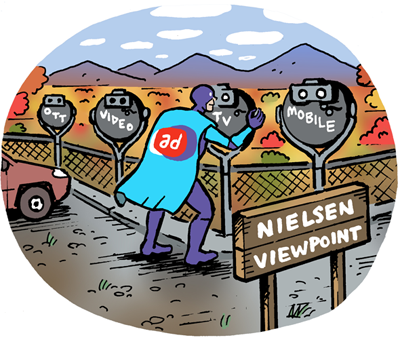
The linear TV industry’s measurement debacle spilled over into the streaming-focused NewFronts last week.
Smart TV manufacturers Samsung, Vizio, LG Ads and Roku all held NewFronts presentations where they bragged about their automatic content recognition (ACR) data, which the industry has been putting on a pedestal because it can add a level of consistency to TV measurement.
Pretty much every company with a streaming distribution business is trying to find a better way to measure its own audience – and do it better than the competition.
ACR-med up
Agencies are clamoring for ACR because it tracks TV viewership at the device level. That level of precision gives smart TV hardware manufacturers a competitive advantage and is why most of them have an ads business.
This year marked Roku’s first NewFronts season as both a streaming platform and a TV manufacturer. Now that the company makes its own smart TV sets and has access to all the data those TVs generate, it’s pitching advertisers on more granular measurement for Roku inventory with its ACR.
“ACR is taking a front seat to our overall data strategy,” Kristina Shepard, Roku’s head of US brand sales, told me ahead of NewFronts week. “We want to make sure we’re putting ACR in the hands of brands and agencies to use in a meaningful way.”
As part of its NewFronts package, Roku announced new advertiser partnerships last month that hinge on its ACR for more accurate measurement.
Roku’s deal with IPG-owned UM gives the agency and its sister agencies exclusive access to measurement reports that include viewership data, while a partnership with Instacart allows the advertiser to match its first-party data with Roku’s ACR to determine whether an ad exposure led to a sale.
Roku isn’t the only one plugging its ACR data for improved measurement. LG Ads also highlighted its ACR data offerings this year, and other hardware companies are using their ACR to build (more) panels.
Count on it
This year, some TV manufacturers are also making audience panels out of all that ACR. (OK, fine, “calibration panels.”)
Samsung Ads announced its new panel built from its ACR data during last week’s NewFronts event, which it expects to hit 5,000 households by 2024. Talk about making Nielsen look big.
Vizio launched an ACR-based panel late last year, and used its recent NewFronts presentation to unveil a new analytics platform that makes Inscape’s ACR data available for custom campaign planning. (Inscape is Vizio’s data and analytics subsidiary.)
In both cases, the point of the panel is accounting for co-viewing to give advertisers a better idea of who is seeing their ads.
Panels might sound like a reversion back to bad habits, but the industry has decided it accepts panels as research tools – just not for valuing a transaction. Unlike measurement, new currency has to be based on big data, a core difference between the two.
Manufacturers with panels also assert that they’re not trying to get involved with currency. The global head of analytics and insights at Samsung Ads told the NewFronts audience that the company is “not in the currency game” with its new panel.
I mean, the industry’s conversations about TV currency are getting super dramatic nowadays, anyway.
Compete or get beat
Speaking of competition, smart TV manufacturers also sell advertisers on the idea that they offer exclusive audiences that can’t be reached or measured on competitor devices.
Vizio also shared fresh stats during its NewFronts event to prove that its audience is exclusive. According to Vizio’s research, 89% of device owners don’t have a Roku-branded TV, 85% don’t have an LG TV and 73% don’t have a Samsung set.
Of course, this would mean audience exclusivity is also the case for other smart TV competitors. LG, for example, claims an exclusive audience, and while exclusivity is great for measurement on individual platforms, it could also mean danger to the future of data interoperability that TV advertisers are demanding.
Manufacturers design their measurement offerings to be exclusive to their companies, which doesn’t tick the box on buyers’ wish lists to compare ad performance across their full inventory portfolio.
This could be resolved once the new joint industry committee (JIC) finalizes its video currency standards, which will allow for safe data sharing between agencies, programmers and certified currencies. Most video currencies are partially built using ACR data.
But until those standards happen, smart TV companies are selling advertisers on the ACR data they’re using to spruce up campaign measurement within their own media footprint.
I mean, it’s not the whole package, but it’s a step in the right direction.
What I want to know is: How much ACR data will actually make it into cross-platform video currencies?
ALSO: You can catch me at the Cynopsis Measurement & Data Conference in New York City next month. I’ll be moderating a panel about CTV measurement on Wednesday, June 14. Check out the agenda here.
Let me know what you think. Hit me up at [email protected].






 By
By 



